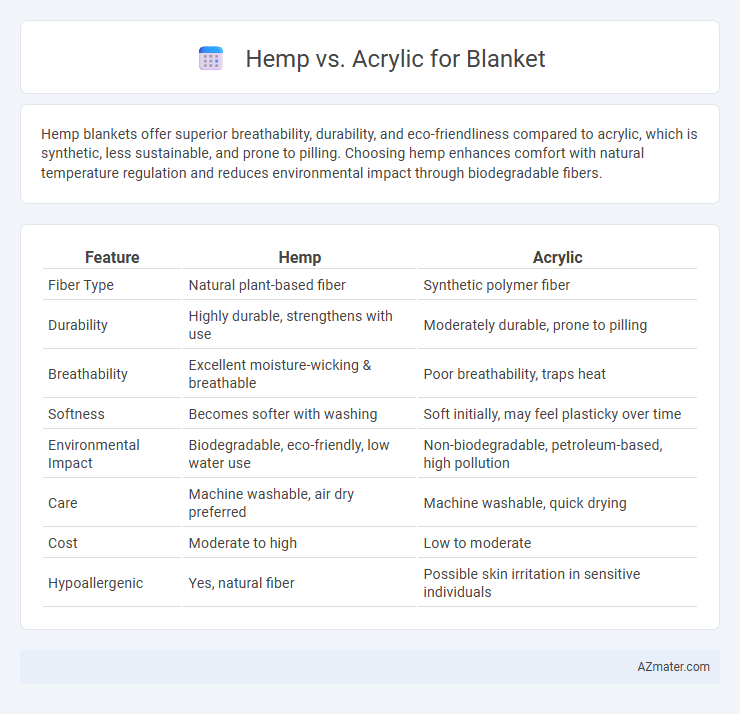Hemp blankets offer superior breathability, durability, and eco-friendliness compared to acrylic, which is synthetic, less sustainable, and prone to pilling. Choosing hemp enhances comfort with natural temperature regulation and reduces environmental impact through biodegradable fibers.
Table of Comparison
| Feature | Hemp | Acrylic |
|---|---|---|
| Fiber Type | Natural plant-based fiber | Synthetic polymer fiber |
| Durability | Highly durable, strengthens with use | Moderately durable, prone to pilling |
| Breathability | Excellent moisture-wicking & breathable | Poor breathability, traps heat |
| Softness | Becomes softer with washing | Soft initially, may feel plasticky over time |
| Environmental Impact | Biodegradable, eco-friendly, low water use | Non-biodegradable, petroleum-based, high pollution |
| Care | Machine washable, air dry preferred | Machine washable, quick drying |
| Cost | Moderate to high | Low to moderate |
| Hypoallergenic | Yes, natural fiber | Possible skin irritation in sensitive individuals |
Introduction to Blanket Materials: Hemp vs Acrylic
Hemp blankets offer natural breathability, durability, and eco-friendly properties, making them ideal for sustainable bedding solutions. Acrylic blankets provide soft texture, lightweight warmth, and affordability, appealing to budget-conscious consumers seeking easy-care options. Understanding the distinct fiber characteristics aids in selecting blankets that balance comfort, longevity, and environmental impact.
Sustainability and Environmental Impact
Hemp blankets offer superior sustainability due to hemp's rapid growth, low water requirements, and minimal pesticide use, resulting in a significantly lower environmental footprint compared to acrylic. Acrylic blankets, derived from petroleum-based synthetic fibers, contribute to non-renewable resource depletion and release microplastics during washing, exacerbating marine pollution. Choosing hemp blankets supports eco-friendly textile production and reduces carbon emissions, making them a greener alternative for sustainable living.
Comfort and Softness Comparison
Hemp blankets offer natural breathability and become softer with each wash, providing a durable yet comfortable texture ideal for sensitive skin. Acrylic blankets mimic the softness of wool but can sometimes feel less breathable and may cause static cling, affecting overall comfort. Choosing between hemp and acrylic blankets depends on desired softness and moisture-wicking properties, with hemp excelling in natural comfort and longevity.
Durability and Longevity of Hemp and Acrylic Blankets
Hemp blankets offer exceptional durability due to hemp fibers' natural strength and resistance to wear, often lasting several years with minimal signs of fraying or pilling. Acrylic blankets, while softer and more affordable, tend to degrade faster, frequently showing thinning and fuzziness after repeated washes. Choosing hemp results in a longer-lasting blanket that maintains structural integrity and resists abrasion, making it ideal for sustainable, high-performance bedding.
Warmth and Insulation Properties
Hemp blankets offer superior breathability and natural moisture-wicking properties, making them effective in regulating body temperature and providing consistent warmth. Acrylic blankets, made from synthetic fibers, excel in trapping heat and offering stronger insulation, which is ideal for extremely cold environments. When choosing between hemp and acrylic, prioritize hemp for eco-friendly, temperature-regulating comfort and acrylic for maximum heat retention in harsh climates.
Hypoallergenic and Skin-Friendly Qualities
Hemp blankets are naturally hypoallergenic and resistant to dust mites and mold, making them ideal for sensitive skin and allergy sufferers. Acrylic blankets may cause irritation for some individuals due to synthetic fibers that can trap allergens and cause static cling. Choosing hemp ensures a breathable, soft texture that promotes skin comfort and reduces the risk of allergic reactions.
Care, Maintenance, and Washing Requirements
Hemp blankets are highly durable and naturally resistant to bacteria and mold, requiring gentle washing in cold water to preserve their strength and texture, with air drying recommended to prevent shrinkage. Acrylic blankets, being synthetic, are easier to maintain as they resist wrinkles and stains and can typically be machine washed on a gentle cycle with mild detergent, drying quickly without the risk of mildew. Proper care for hemp emphasizes delicate handling to maintain its eco-friendly benefits, while acrylic offers convenience and quick upkeep suited for everyday use.
Cost and Affordability Analysis
Hemp blankets typically cost more upfront due to sustainable cultivation and eco-friendly processing methods, but their durability often results in long-term savings. Acrylic blankets are generally more affordable initially, offering budget-friendly options with vibrant color choices but may wear out faster, leading to replacement expenses. Comparing both, hemp provides a cost-effective investment over time, while acrylic suits those seeking immediate low-cost blankets.
Style, Color, and Texture Options
Hemp blankets offer a natural, earthy aesthetic with a limited yet sophisticated color palette, emphasizing muted tones like beige, olive, and stone that complement eco-friendly and rustic styles. Acrylic blankets provide a vast array of vibrant colors and patterns, appealing to those seeking bold, contemporary designs with a smooth, consistent texture. Texture-wise, hemp delivers a coarse, organic feel that softens with use, while acrylic presents a plush, silky surface that maintains its softness over time.
Choosing the Right Material for Your Blanket
Hemp blankets offer exceptional durability, breathability, and natural antibacterial properties, making them ideal for eco-conscious users seeking sustainable and hypoallergenic options. Acrylic blankets provide vibrant colors, softness, and affordability, appealing to those prioritizing easy care and warmth without natural fibers. Choosing the right material depends on balancing preferences for environmental impact, texture, maintenance, and insulation needs.

Infographic: Hemp vs Acrylic for Blanket
 azmater.com
azmater.com